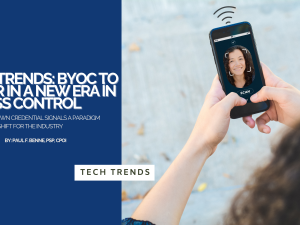Paul F. Benne
March 2025 – Security Business Magazine
The evolution of security technology has led to a significant shift from traditional on-premises video surveillance and access control systems to cloud-based solutions. Organizations must carefully weigh the economic implications and critical system reliability when deciding between these two approaches. The advantages and disadvantages of each solution are not always clear, as their impact on operational costs, scalability, security, and reliability must be considered.
Given that this trend has no end in sight, let’s look at some considerations of Cloud-Based Video Surveillance and Access Control Systems.
Pros
- Cost Efficiency and Scalability
Cloud-based systems reduce the need for significant upfront capital expenditures. Instead of purchasing expensive servers and storage devices, organizations can opt for a subscription-based model that spreads costs over time. This pay-as-you-go model allows businesses to scale their security infrastructure without large financial investments,
- Remote Accessibility
One of the standout benefits of cloud-based security solutions is remote access. Administrators can monitor and control security operations from anywhere using internet-connected devices. This flexibility enhances security management, especially for businesses with multiple locations.
- Automatic Updates and Maintenance
Cloud providers handle software updates, security patches, and maintenance automatically, ensuring systems are always up-to-date with the latest features and protections. This reduces the burden on in-house IT teams and lowers maintenance costs.
- Data Redundancy and Disaster Recovery
Cloud providers offer robust data redundancy, storing surveillance footage and access logs in multiple locations to prevent data loss. In case of hardware failure, natural disasters, or cyberattacks, data recovery is swift and reliable.
- Integration with Other Cloud Services
Cloud-based security systems often can integrate seamlessly with other cloud-based services, such as AI-powered analytics, machine learning for threat detection, and third-party applications that enhance functionality.
Cons
- Ongoing Subscription Costs
While cloud solutions reduce initial costs, the recurring subscription fees can add up over time. For organizations with tight budgets, don’t jump to fast to dodge the capital expense of an on prem system, because the long-term operating expense may be a concern.
- Internet Dependency and Latency Issues
Cloud-based systems rely on a stable internet connection. If connectivity is lost or slow, or limited in bandwidth, security monitoring and access control could be delayed, posing a risk in critical situations.
- Data Privacy and Compliance Risks
Storing security data on external servers raises concerns about data privacy, regulatory compliance, and unauthorized access. Some industries, such as finance and healthcare, have stringent data protection regulations that might limit the use of cloud solutions.
- Limited Customization
Cloud-based security services are often standardized, with limited options for customization. Businesses with specific security requirements might find it challenging to tailor cloud solutions to their needs.
However, On-Premises Video Surveillance and Access Control Systems have their own set of considerations to evaluate.
Pros
- Greater Control and Security
On-premises systems allow organizations to retain full control over their security infrastructure, reducing reliance on third-party providers. Data is stored locally, reducing the risk of external breaches.
- No Dependency on Internet Connectivity
Unlike cloud-based systems, on-premises solutions continue operating independently of internet availability, ensuring uninterrupted surveillance and access control. If you are a critical facility this point cannot be overlooked.
- Customizable Solutions
Businesses with unique security requirements can tailor on-premises systems to fit their specific needs, adjusting hardware and software configurations as necessary.
- One-Time Investment with No Recurring Fees
On-premises solutions typically involve a one-time capital investment, eliminating ongoing subscription fees. Over time, this can be more cost-effective than cloud-based models.
- Compliance and Regulatory Adherence
Some industries have strict data retention and privacy regulations that favor on-premises solutions. Keeping data stored locally ensures compliance with policies that restrict cloud-based storage.
Cons
- High Initial Costs
Deploying an on-premises security system requires substantial upfront investment in hardware, software, and installation. This cost can be prohibitive for small and medium-sized businesses.
- Limited Scalability
Expanding an on-premises system often means purchasing additional hardware and upgrading infrastructure, making scalability more complex and expensive compared to cloud solutions.
- Maintenance and IT Burden
Organizations must handle system maintenance, software updates, and troubleshooting. This requires dedicated personnel and resources, increasing operational costs.
- Risk of Data Loss
On-premises systems depend on physical storage, which can be vulnerable to hardware failures, fire, theft, or natural disasters. Without proper redundancy measures, data loss can be a significant risk.
When comparing cloud-based and on-premises systems, total cost of ownership (TCO) plays a critical role. Cloud-based solutions typically have lower upfront costs but involve continuous subscription fees. On-premises systems demand higher initial investments but may prove more cost-effective over several years if maintenance and upgrade costs are managed efficiently.
For small businesses or startups with limited capital, cloud-based solutions offer an affordable entry point with predictable costs. Larger enterprises, particularly those with stringent regulatory requirements, may find on-premises solutions more suitable for long-term cost efficiency.
Security infrastructure must also be highly reliable and resilient against potential threats. Cloud-based solutions offer strong redundancy but depend on external providers for uptime and security patches. On-premises systems provide complete control but require dedicated teams to manage and secure data effectively.
Cybersecurity is another key concern. Cloud providers invest heavily in security measures such as encryption, intrusion detection, and access controls. However, centralized storage presents a high-value target for hackers. On-premises solutions reduce exposure but require robust internal security protocols to prevent breaches.
So, what is the better choice? The decision between cloud-based and on-premises video surveillance and access control systems depends on a close evaluation of the pros and cons. Ultimately, businesses should conduct a thorough risk assessment before making a decision. In some cases, a hybrid approach may offer the best balance between cost efficiency, security, and scalability.







